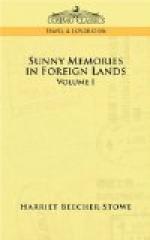Now, if you do not remember Scott’s poem, of the Eve of St. John, you ought to read it over; for it is, I think, the most spirited of all his ballads; nothing conceals the transcendent lustre and beauty of these compositions, but the splendor of his other literary productions. Had he never written any thing but these, they would have made him a name as a poet. As it was, I found the fanciful chime of the cadences in this ballad ringing through my ears. I kept saying to myself—
“The Dryburgh bells do ring,
And the white monks do sing
For Sir Richard of Coldinghame.”
And as I was wandering around in the labyrinth, of old, broken, mossy arches, I thought—
“There is a nun in Dryburgh bower
Ne’er looks upon the
sun;
There is a monk in Melrose tower,
He speaketh word to none.
That nun who ne’er beholds the day,
That monk who speaks to none,
That nun was Smaylhome’s lady gay,
That monk the bold Baron.”
It seems that there is a vault in this edifice which has had some superstitious legends attached to it, from having been the residence, about fifty years ago, of a mysterious lady, who, being under a vow never to behold the light of the sun, only left her cell at midnight. This little story, of course, gives just enough superstitious chill to this beautiful ruin to help the effect of the pointed arches, the clinging wreaths of ivy, the shadowy pines, and yew trees; in short, if one had not a guide waiting, who had a bad cold, if one could stroll here at leisure by twilight or moonlight, one might get up a considerable deal of the mystic and poetic.
There is a part of the ruin that stands most picturesquely by itself, as if old Time had intended it for a monument. It is the ruin of that part of the chapel called St. Mary’s Aisle; it stands surrounded by luxuriant thickets of pine and other trees, a cluster of beautiful Gothic arches supporting a second tier of smaller and more fanciful ones, one or two of which have that light touch of the Moorish in their form which gives such a singular and poetic effect in many of the old Gothic ruins. Out of these wild arches and windows wave wreaths of ivy, and slender harebells shake their blue pendants, looking in and out of the lattices like little capricious fairies. There are fragments of ruins lying on the ground, and the whole air of the thing is as wild, and dreamlike, and picturesque as the poet’s fanciful heart could have desired.
Underneath these arches he lies beside his wife; around him the representation of the two things he loved most—the wild bloom and beauty of nature, and the architectural memorial of by-gone history and art. Yet there was one thing I felt I would have had otherwise; it seemed to me that the flat stones of the pavement are a weight too heavy and too cold to be laid on the breast of a lover of nature and the beautiful. The green turf, springing with flowers, that lies above a grave, does not seem, to us so hopeless a barrier between us and what was warm and loving; the springing grass and daisies there seem, types and assurances that the mortal beneath shall put on immortality; they come up to us as kind messages from the peaceful dust, to say that it is resting in a certain hope of a glorious resurrection.




